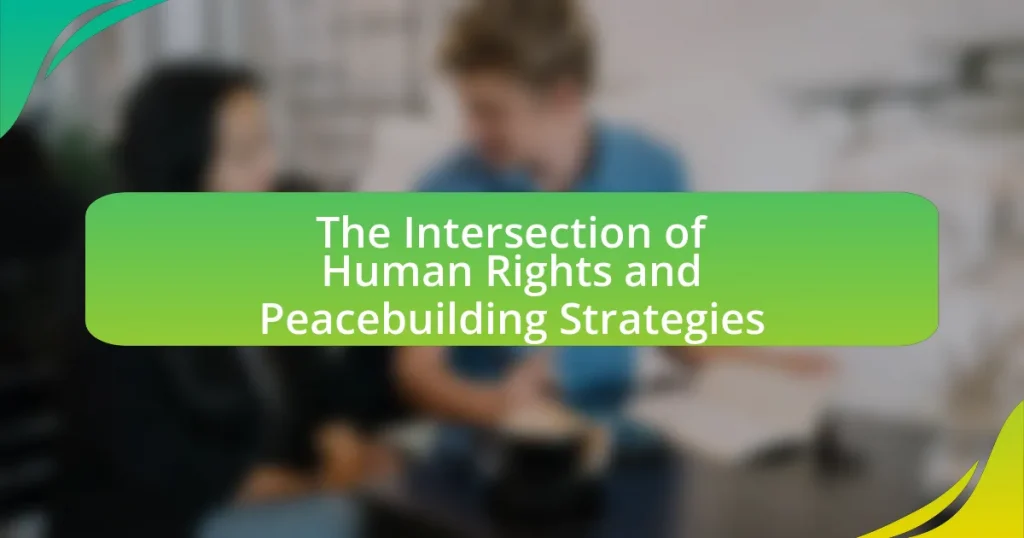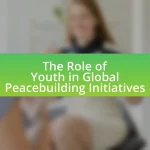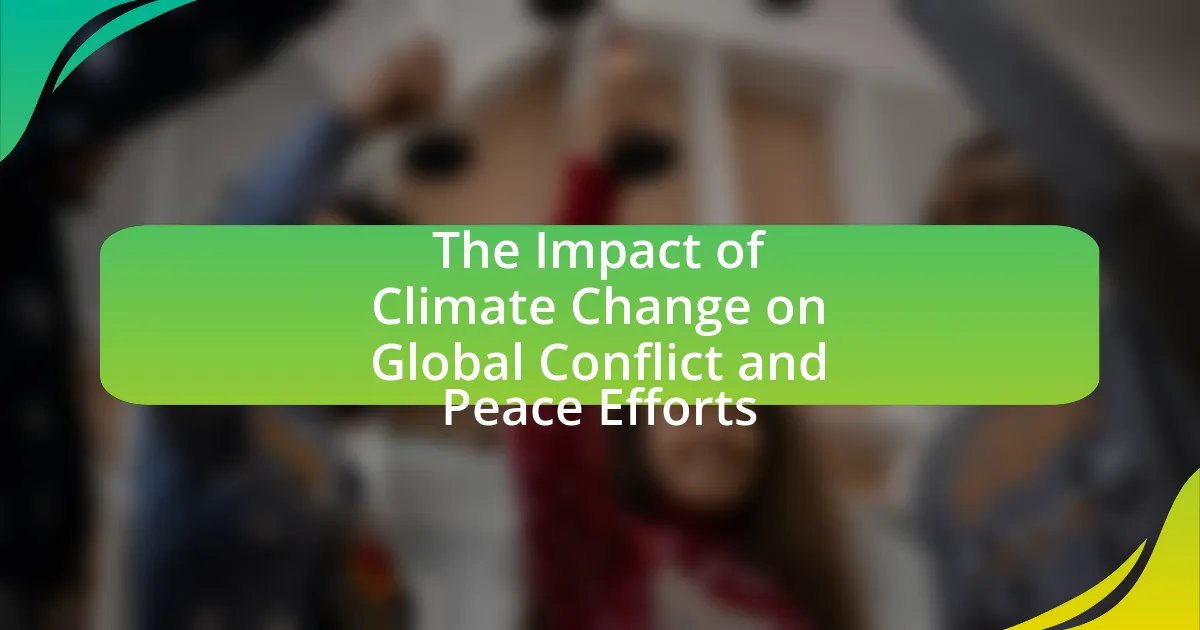The article examines the intersection of human rights and peacebuilding strategies, highlighting their shared objective of fostering sustainable peace and justice. It discusses how human rights frameworks address grievances that can lead to conflict, while peacebuilding efforts promote social cohesion and reconciliation. Key principles of human rights relevant to peacebuilding, such as the right to life and freedom from torture, are outlined, along with the challenges of integrating these principles into peacebuilding strategies. The article also emphasizes the importance of local cultures, political contexts, and collaborative approaches in enhancing the effectiveness of peacebuilding initiatives that prioritize human rights. Successful case studies, such as South Africa’s Truth and Reconciliation Commission and Colombia’s peace agreement, illustrate the positive outcomes of this integration.
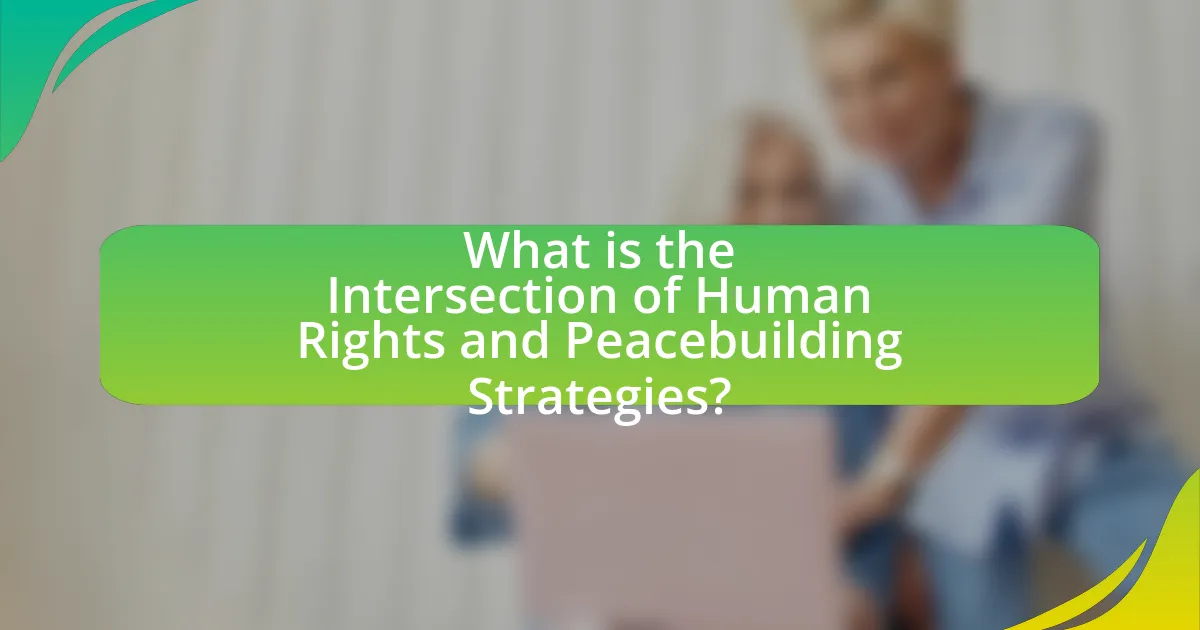
What is the Intersection of Human Rights and Peacebuilding Strategies?
The intersection of human rights and peacebuilding strategies lies in their mutual goal of fostering sustainable peace and justice. Human rights frameworks provide essential guidelines for addressing grievances and injustices that often fuel conflict, while peacebuilding strategies aim to create conditions for lasting peace by promoting social cohesion and reconciliation. For instance, the United Nations emphasizes that respecting human rights is crucial for effective peacebuilding, as violations can lead to renewed violence. Furthermore, research indicates that countries with strong human rights protections are less likely to experience conflict, highlighting the importance of integrating human rights into peacebuilding efforts.
How do human rights and peacebuilding intersect in practice?
Human rights and peacebuilding intersect in practice through the promotion of justice, accountability, and social cohesion in post-conflict settings. Peacebuilding efforts often incorporate human rights frameworks to address grievances that may lead to conflict, ensuring that marginalized groups are included in the peace process. For example, the United Nations’ Sustainable Development Goal 16 emphasizes the importance of promoting peaceful and inclusive societies, which directly links human rights to peacebuilding initiatives. Furthermore, historical cases, such as the Truth and Reconciliation Commission in South Africa, demonstrate how addressing human rights violations can foster healing and stability, thereby reinforcing the connection between human rights and sustainable peace.
What are the key principles of human rights relevant to peacebuilding?
The key principles of human rights relevant to peacebuilding include the right to life, freedom from torture, the right to a fair trial, and the right to freedom of expression. These principles are essential for establishing a just and peaceful society, as they promote individual dignity and protect against abuses that can lead to conflict. For instance, the right to life ensures that individuals are protected from violence, while freedom from torture safeguards against inhumane treatment that can escalate tensions. Furthermore, the right to a fair trial upholds justice and accountability, which are crucial for rebuilding trust in post-conflict societies. Lastly, freedom of expression allows for open dialogue and participation in governance, fostering an inclusive environment that can prevent future conflicts. These principles are enshrined in international human rights instruments, such as the Universal Declaration of Human Rights, which underscores their importance in peacebuilding efforts.
How do peacebuilding strategies incorporate human rights considerations?
Peacebuilding strategies incorporate human rights considerations by integrating the protection and promotion of human rights into their frameworks and processes. These strategies emphasize the importance of addressing root causes of conflict, which often include human rights violations such as discrimination, repression, and inequality. For instance, the United Nations’ Sustainable Development Goals highlight the necessity of ensuring justice and promoting peaceful societies, recognizing that human rights are fundamental to achieving lasting peace. Furthermore, successful peace agreements often include provisions for human rights protections, accountability mechanisms, and the establishment of transitional justice processes, which are essential for rebuilding trust and fostering social cohesion in post-conflict societies.
Why is the intersection of human rights and peacebuilding important?
The intersection of human rights and peacebuilding is important because it fosters sustainable peace by addressing the root causes of conflict and promoting justice. When human rights are prioritized in peacebuilding efforts, it helps to create inclusive societies where grievances are addressed, reducing the likelihood of future violence. For instance, the United Nations emphasizes that respecting human rights is essential for lasting peace, as evidenced by the success of peace agreements that incorporate human rights protections, such as the 1995 Dayton Agreement in Bosnia and Herzegovina, which included provisions for human rights and minority protections. This integration not only enhances the legitimacy of peace processes but also empowers communities to participate actively in rebuilding their societies, thereby reinforcing both peace and human rights.
What impact does the protection of human rights have on peacebuilding outcomes?
The protection of human rights significantly enhances peacebuilding outcomes by fostering trust and cooperation among communities. When human rights are upheld, individuals feel valued and secure, which reduces grievances that can lead to conflict. For instance, the United Nations Development Programme (UNDP) emphasizes that respect for human rights is essential for sustainable peace, as it addresses root causes of violence and promotes social cohesion. Furthermore, countries that prioritize human rights often experience lower levels of violence and greater political stability, as evidenced by research from the World Bank, which indicates that nations with strong human rights records tend to have more effective governance and less civil unrest.
How can violations of human rights undermine peacebuilding efforts?
Violations of human rights significantly undermine peacebuilding efforts by eroding trust between communities and institutions. When individuals experience abuses such as torture, discrimination, or unlawful killings, it fosters resentment and hostility, making reconciliation difficult. For instance, in post-conflict societies like Rwanda, human rights violations during the genocide created deep societal divisions that hindered long-term peace and stability. Furthermore, the lack of accountability for such violations can perpetuate cycles of violence, as seen in countries like Syria, where ongoing human rights abuses have obstructed peace negotiations and prolonged conflict. Thus, ensuring respect for human rights is essential for building sustainable peace and fostering social cohesion.
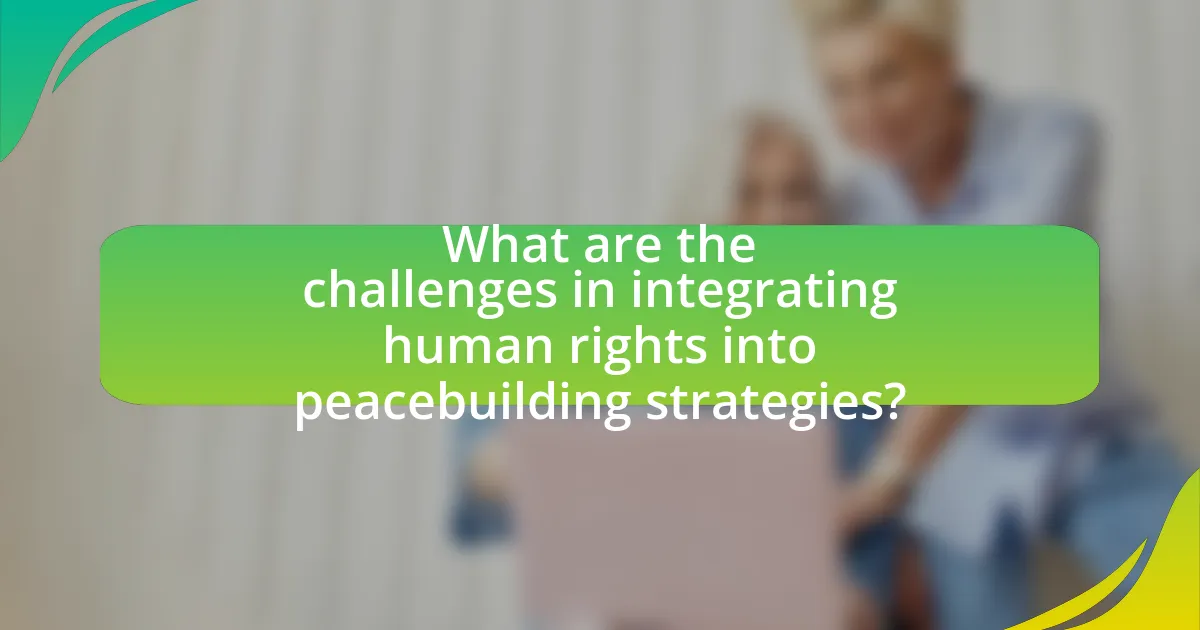
What are the challenges in integrating human rights into peacebuilding strategies?
Integrating human rights into peacebuilding strategies faces several challenges, primarily due to conflicting priorities and the complexity of local contexts. One significant challenge is the tension between immediate security needs and long-term human rights goals, as peacebuilding often prioritizes stability over justice. Additionally, the lack of local ownership and understanding of human rights principles can hinder effective implementation, as seen in various post-conflict scenarios where communities may prioritize economic recovery over human rights advocacy. Furthermore, the political will of key stakeholders can be inconsistent, leading to insufficient support for human rights initiatives within peacebuilding frameworks. These challenges are evident in cases like the peace process in Colombia, where despite significant strides, issues of land rights and social justice remain contentious and unresolved.
What obstacles do practitioners face in this integration?
Practitioners face several obstacles in integrating human rights and peacebuilding strategies, primarily including conflicting priorities, lack of resources, and insufficient training. Conflicting priorities arise when peacebuilding efforts prioritize stability over human rights, leading to compromises that undermine justice and accountability. Lack of resources, both financial and human, hampers the ability to implement comprehensive strategies that address both peace and human rights effectively. Insufficient training for practitioners in both fields can result in a lack of understanding of how to harmonize these approaches, ultimately limiting the effectiveness of their initiatives. These challenges are documented in various studies, including the United Nations’ “Guidance for Effective Mediation,” which highlights the need for a balanced approach to ensure sustainable peace that respects human rights.
How do political contexts affect the implementation of human rights in peacebuilding?
Political contexts significantly influence the implementation of human rights in peacebuilding by shaping the priorities and actions of governing bodies and institutions. In environments where political stability is fragile or where there is a lack of commitment to human rights, peacebuilding efforts often prioritize security and order over the protection of individual rights. For instance, in post-conflict societies, governments may suppress dissent and limit freedoms to maintain control, undermining human rights initiatives. Historical examples include the peace processes in countries like Rwanda and Bosnia, where political leaders prioritized power consolidation over human rights, leading to ongoing violations. Additionally, international actors may also adapt their strategies based on the political landscape, often compromising on human rights to secure peace agreements, as seen in various negotiations in the Middle East. Thus, the political context directly affects the effectiveness and prioritization of human rights within peacebuilding frameworks.
What role do local cultures and norms play in this integration?
Local cultures and norms significantly influence the integration of human rights and peacebuilding strategies by shaping community values and behaviors. These cultural frameworks determine how individuals perceive justice, reconciliation, and the protection of rights, often dictating the acceptance and effectiveness of peace initiatives. For instance, in many societies, traditional conflict resolution practices are rooted in local customs, which can either complement or conflict with formal human rights frameworks. Research indicates that peacebuilding efforts that align with local cultural norms tend to achieve higher levels of community support and sustainability, as seen in the case of the Truth and Reconciliation Commission in South Africa, which incorporated indigenous practices to foster healing and dialogue. Thus, understanding and integrating local cultures and norms is essential for the successful implementation of human rights and peacebuilding strategies.
How can these challenges be addressed?
Challenges at the intersection of human rights and peacebuilding strategies can be addressed through the integration of human rights frameworks into peace processes. This integration ensures that peacebuilding efforts are not only focused on ending conflict but also on promoting justice, accountability, and the protection of individual rights. For instance, the United Nations has emphasized the importance of incorporating human rights into peacebuilding initiatives, as seen in the 2016 Sustaining Peace Resolution, which highlights the need for a holistic approach that includes human rights considerations. By aligning peacebuilding strategies with human rights principles, stakeholders can create more sustainable and inclusive outcomes that address the root causes of conflict and promote long-term stability.
What strategies can enhance the integration of human rights in peacebuilding?
Strategies that can enhance the integration of human rights in peacebuilding include establishing inclusive dialogue mechanisms, promoting accountability for human rights violations, and ensuring the participation of marginalized groups. Inclusive dialogue mechanisms, such as community forums, allow diverse voices to contribute to peace processes, fostering a sense of ownership and legitimacy. Promoting accountability through legal frameworks and transitional justice mechanisms addresses past abuses, which is essential for rebuilding trust and preventing future conflicts. Ensuring the participation of marginalized groups, including women and minorities, is critical, as their perspectives can lead to more comprehensive and sustainable peace agreements. Research by the United Nations indicates that peace agreements that include provisions for human rights and gender equality are 35% more likely to last at least 15 years.
How can collaboration between stakeholders improve outcomes?
Collaboration between stakeholders can significantly improve outcomes by fostering shared goals and leveraging diverse expertise. When various stakeholders, such as governments, NGOs, and community organizations, work together, they can pool resources, enhance communication, and create comprehensive strategies that address complex issues. For instance, a study by the United Nations Development Programme highlighted that collaborative approaches in peacebuilding initiatives led to a 30% increase in project effectiveness, as stakeholders were able to align their efforts and address the root causes of conflict more effectively. This synergy not only enhances the quality of interventions but also builds trust among communities, ultimately leading to more sustainable and impactful results in human rights and peacebuilding efforts.

What are the best practices for aligning human rights with peacebuilding strategies?
The best practices for aligning human rights with peacebuilding strategies include integrating human rights education into peacebuilding initiatives, ensuring inclusive participation of marginalized groups, and establishing accountability mechanisms for human rights violations. Integrating human rights education fosters a culture of respect and understanding, which is essential for sustainable peace. Inclusive participation ensures that the voices of all community members, especially those historically marginalized, are heard and considered in peace processes, leading to more equitable outcomes. Establishing accountability mechanisms, such as truth commissions or judicial processes, addresses past injustices and reinforces the rule of law, which is critical for building trust in post-conflict societies. These practices are supported by various studies, including the United Nations’ “Guiding Principles on Business and Human Rights,” which emphasize the importance of human rights in fostering stable and peaceful societies.
What successful case studies exist in this field?
Successful case studies in the intersection of human rights and peacebuilding strategies include the Truth and Reconciliation Commission in South Africa and the peace process in Colombia. The Truth and Reconciliation Commission, established in 1995, aimed to address human rights violations during apartheid, fostering national healing and reconciliation. It documented abuses and provided a platform for victims to share their experiences, contributing to a more peaceful society. In Colombia, the 2016 peace agreement between the government and the FARC guerrilla group incorporated human rights protections and transitional justice mechanisms, significantly reducing violence and promoting social inclusion. These case studies demonstrate the effectiveness of integrating human rights into peacebuilding efforts, leading to sustainable peace and justice.
How did specific peacebuilding initiatives effectively incorporate human rights?
Specific peacebuilding initiatives effectively incorporated human rights by embedding human rights education and advocacy into their frameworks. For instance, the United Nations’ Peacebuilding Fund has prioritized projects that promote human rights as a foundational element for sustainable peace, ensuring that local communities are engaged in dialogue about their rights. Additionally, the Truth and Reconciliation Commission in South Africa integrated human rights principles by addressing past injustices and fostering accountability, which helped to rebuild trust among communities. These initiatives demonstrate that incorporating human rights not only addresses grievances but also empowers individuals, creating a more inclusive and resilient society.
What lessons can be learned from these case studies?
The lessons learned from these case studies highlight the critical importance of integrating human rights into peacebuilding strategies. Effective peacebuilding requires addressing underlying grievances related to human rights violations, as evidenced by the success of initiatives that prioritize justice and accountability. For instance, the case studies demonstrate that communities that engage in truth and reconciliation processes experience more sustainable peace, as seen in South Africa’s post-apartheid transition. Furthermore, the evidence indicates that inclusive dialogue involving marginalized groups leads to more comprehensive and lasting peace agreements, as illustrated by the peace process in Colombia. These findings underscore that neglecting human rights in peacebuilding can lead to renewed conflict, reinforcing the need for a holistic approach that prioritizes both peace and justice.
What tools and frameworks support this alignment?
Tools and frameworks that support the alignment of human rights and peacebuilding strategies include the United Nations Sustainable Development Goals (SDGs), the United Nations Human Rights Council mechanisms, and the Guiding Principles on Business and Human Rights. The SDGs provide a comprehensive framework that integrates human rights into development and peacebuilding efforts, emphasizing the importance of inclusive societies. The UN Human Rights Council mechanisms, such as Universal Periodic Review, facilitate accountability and promote human rights standards essential for sustainable peace. The Guiding Principles on Business and Human Rights outline the responsibilities of businesses to respect human rights, which is crucial in conflict-affected areas where peacebuilding efforts are underway. These frameworks collectively reinforce the necessity of integrating human rights into peacebuilding initiatives to achieve lasting stability and justice.
What role do international human rights laws play in peacebuilding?
International human rights laws play a crucial role in peacebuilding by establishing a framework that promotes justice, accountability, and the protection of individual rights. These laws help to prevent conflicts by addressing grievances and ensuring that all individuals are treated with dignity and respect, which can mitigate tensions that lead to violence. For instance, the Universal Declaration of Human Rights outlines fundamental rights that, when upheld, contribute to social stability and cohesion. Furthermore, adherence to international human rights standards can foster trust between communities and governments, as seen in post-conflict societies where transitional justice mechanisms, such as truth commissions, are implemented to address past abuses and promote reconciliation. This relationship between human rights and peacebuilding is supported by various studies, including the 2011 report by the United Nations Human Rights Council, which emphasizes that respect for human rights is essential for sustainable peace and security.
How can monitoring and evaluation frameworks enhance accountability?
Monitoring and evaluation frameworks enhance accountability by providing structured processes for assessing performance and outcomes. These frameworks establish clear indicators and benchmarks that organizations can use to measure progress against defined goals, ensuring transparency in operations. For instance, the United Nations Development Programme emphasizes that systematic monitoring allows stakeholders to track resource allocation and project effectiveness, thereby holding entities accountable for their commitments. By regularly collecting and analyzing data, these frameworks facilitate informed decision-making and promote responsible governance, ultimately reinforcing trust among stakeholders in human rights and peacebuilding initiatives.
What practical steps can organizations take to improve their strategies?
Organizations can improve their strategies by conducting comprehensive assessments of their current practices and aligning them with human rights principles. This involves evaluating existing policies, identifying gaps, and integrating human rights frameworks into peacebuilding efforts. For instance, the United Nations Development Programme emphasizes the importance of incorporating human rights into development strategies to foster sustainable peace. Additionally, organizations should engage stakeholders, including local communities and human rights advocates, to ensure that strategies are inclusive and contextually relevant. Research indicates that participatory approaches enhance the effectiveness of peacebuilding initiatives, as seen in the work of the International Crisis Group, which highlights the success of community-driven strategies in conflict resolution.
How can organizations assess their current approaches to human rights and peacebuilding?
Organizations can assess their current approaches to human rights and peacebuilding by conducting comprehensive evaluations that include stakeholder consultations, policy reviews, and impact assessments. These evaluations should involve gathering qualitative and quantitative data from affected communities, analyzing existing policies against international human rights standards, and measuring the outcomes of peacebuilding initiatives. For instance, organizations can utilize frameworks such as the United Nations Guiding Principles on Business and Human Rights to benchmark their practices. Additionally, employing tools like the Human Rights Impact Assessment can provide concrete insights into the effectiveness of their strategies, ensuring alignment with both human rights obligations and peacebuilding goals.
What recommendations can be made for future initiatives in this area?
Future initiatives in the intersection of human rights and peacebuilding strategies should prioritize the integration of human rights education into peacebuilding programs. This approach fosters a culture of respect for human rights, which is essential for sustainable peace. Evidence from the United Nations suggests that countries with strong human rights frameworks experience lower levels of conflict and violence. Additionally, involving local communities in the design and implementation of peacebuilding initiatives ensures that the strategies are culturally relevant and more likely to succeed, as demonstrated by successful case studies in countries like Liberia and South Africa.
